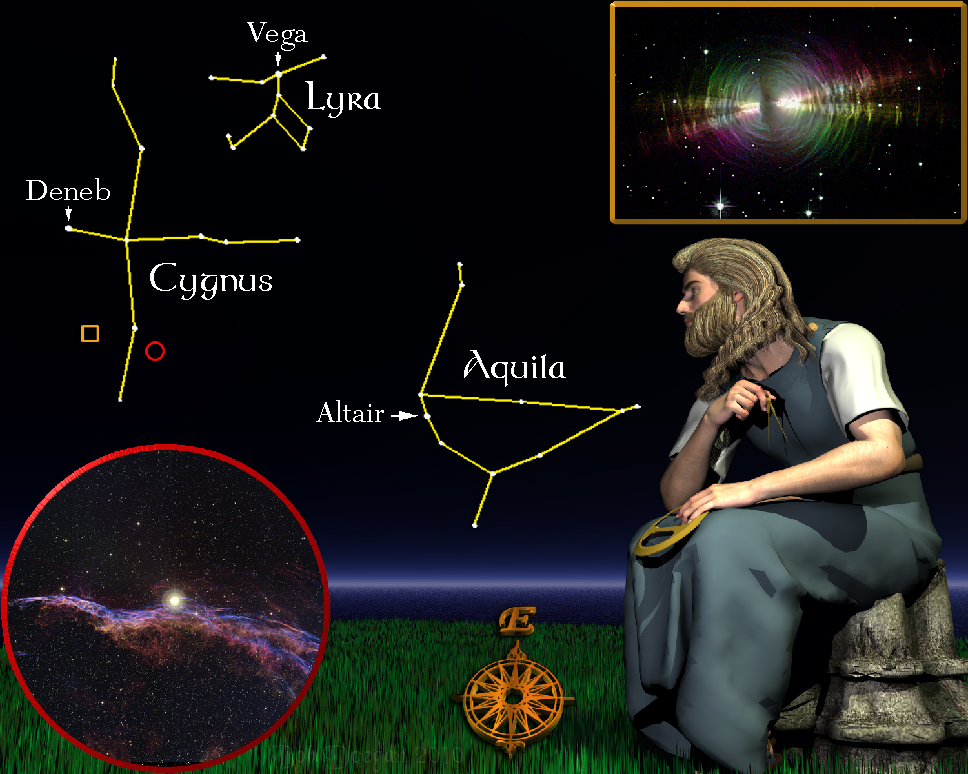
For the week including June 25, 2010

THE SUMMER TRIANGLE
Summer is here and with the warming weather, three bright stars rise above the eastern horizon in the early evening. They are so much brighter than any of the other eastern stars many people wonder if they’re part of some very large constellation. Actually these stars are the most prominent members of separate constellations, but as a group they are known as the Summer Triangle. In the time of the ancient Greeks, the calculation of their rising times was a standard test of astronomical scholarship. The Triangle stars are conspicuous throughout the summer months but remain visible for the rest of the year. As sunsets come earlier and earlier as autumn moves into winter, the Summer Triangle stars won’t have time to set before night falls.
Vega, in the constellation of Lyra the Harp, is the most brilliant of the stars in the triangle and is easy to locate midway to the top of the sky. Vega is a brilliant blue-white in color and is the fifth brightest star in the heavens. As our Sun revolves around the galaxy, it is moving toward Vega at a speed of twelve miles a second. At this rate, it will take us another 450,000 years to reach where Vega is now.
Altair, in Aquila the Eagle, is the twelfth brightest star and one of the nearest bright stars to us, but its rapid rotation sets it apart from other stars. While our Sun requires twenty-five days to complete its rotation, Altair, which is half again its size, spins around in a little over six days. This rapid spin creates tremendous centrifugal forces on Altair, giving it a somewhat flattened, egg-shape.
Deneb, the tail of Cygnus the Swan, seems to be the faintest of the stars that constitute the triangle, but this is due to its great distance from earth. At 1,600 light years away, Deneb is probably the most remote of the bright stars. If the supergiant Deneb were as close as our sun, it would shine 60,000 times brighter. The Swan contains more than a few deep space wonders:
CRL 2688 (squared area): The Hubble photograph at upper right gives a rare glimpse at a planetary nebula that’s only a few thousand years old. The shells of gases expanding away from the star, like the rings of a tree trunk, tell us the age of their formation. Moving at over 100,000 miles an hour, the shells were thrown away from the star at intervals ranging from 100 to 500 years.
The Veil Nebula (circled area): One of my favorite telescopic objects and surely one of the most beautiful, the Veil Nebula is a supernova remnant. Remnants like the Veil are huge fields of gases, dust and debris riding the crests of shock waves that resulted from the explosion of a very massive star. Shown in the National Optical Astronomy Observatory photograph at lower left, astronomers have placed the nebula at a distance of 2,500 light years and determined that the initial star detonation occurred some 15,000 years ago. Since then the blast has grown to encompass an area of sky six times larger than the full Moon.
Unless otherwise indicated, all content of this web site is the copyright of Robert Deegan and all rights are reserved.
For more information, or to comment, please contact: Bob@NightSkies.org